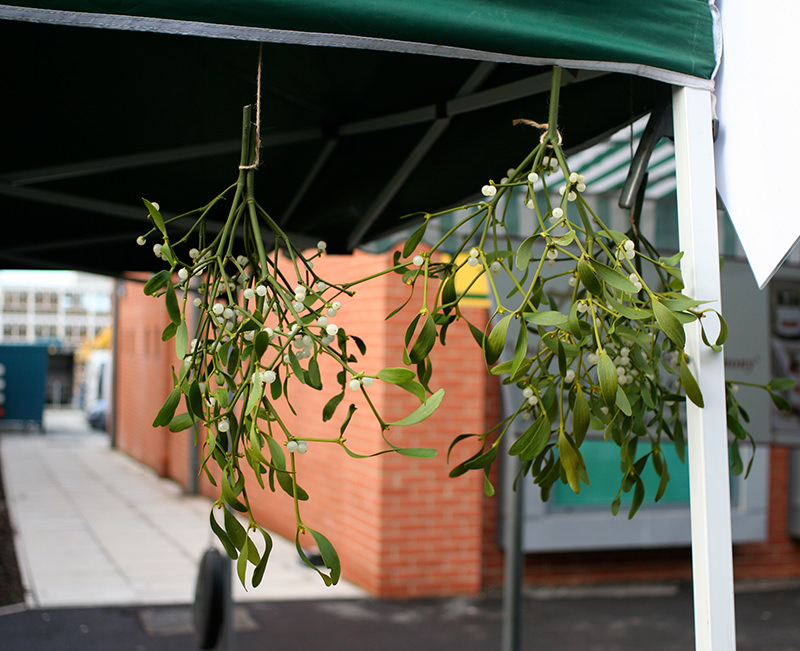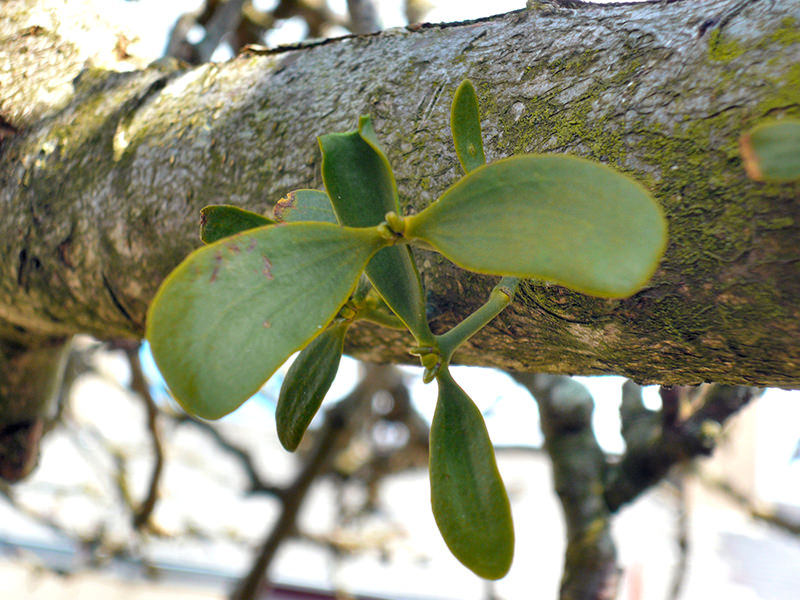
Mistletoe is a common sight in homes during Christmas and is part of our caroling tradition. It has even taken root in literature—the room that Scrooge enters to find the Spirit of Christmas Present is thickly hung with mistletoe. I can’t pretend that I don’t see any reason why mistletoe would garner such fascination. First, it is an evergreen and therefore has the same importance in the winter months as holly and ivy. There are traditions and myth associated with mistletoe in many cultures around the world, but much confusion about how our current use of it came to be.
As a plant geek, I’d contend that the title “mistletoe” is rather vague, having been attached as a common name to many individual plant species. If we are interested in tracking down the original plant in the European tradition it is Viscum album. In North America, the mistletoe that we decorate our houses with and can find growing in our trees is Phoradendron leucarpum. The common thread between the two is the current practice of kissing under the mistletoe and the fascinating way in which they grow.
Plant Freeloader Or Hospitable Host?

Mistletoe is a name to loosely describe several hundred plants that have the habit of growing on another plant as a parasite. Mistletoe is unique in that it is only half parasite though. It can make its own food from the sun using photosynthesis, but it prefers to live off the energy of another plant.
Mistletoe starts life off as a very sticky seed. It needs to be sticky so that it can sit on top of a tree branch and wait to germinate. The plant begins life more as an epiphyte than anything else. The new leaves get their own food and merely use the branch as a resting place. As soon as its roots penetrate the outer layer of the host plant, it becomes a lazy freeloader and stops supporting itself. In some cases, mistletoe can grow to be so massive that it literally sucks the host plant dry and kills it.
If you’re like me, right about now you may be questioning why we use a parasitic plant that kills its host as a festive symbol of love and fertility! What in the world kind of message does that send?!
Mistletoe is much more than a parasite. The fascinating ways that the plant works with and depends on the animal world begin with the fact that the seed is so very sticky. In getting the fruit, birds tend to get the seed stuck to their bill and must wipe it off on the branch where they’re sitting.
The prospect of dying trees may cast mistletoe as a villain and in fact, there are some areas that classify the plant as an invasive. The truth seems to be somewhere in the middle. It is possible to remove a mistletoe invasion by pruning the tree where the mistletoe has begun to grow, though there is some evidence that where mistletoe grows an increase in wildlife populations and pollinators. Mistletoe provides food and shelter to a long list of animals, so maybe you’ll want to think twice before removing it from your trees.
When I see mistletoe this season I’m going to remember the phrase, “It’s complicated.” In some cases, mistletoe can be so dependent that it kills its partner with its neediness. In most cases, I think it earns its reputation as an agent of fertility. Perhaps we need to look at the picture from a new perspective. Up close, we see one plant feeding on another, but with a wider lens, we see that mistletoe feeds on the nutrition and energy of its host tree and in return it brings a greater diversity in the community around it. Mistletoe attracts friends, company, pollinators and the busy activities of many feet. As it hangs in our homes, it does the very same thing!




